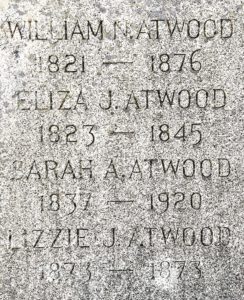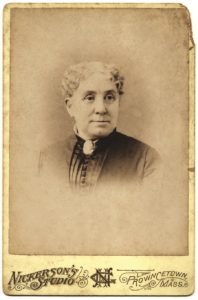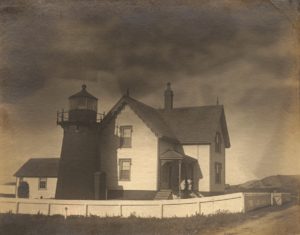With the April 1861 bombardment of Fort Sumter — the Union garrison in Charleston Harbor — civil war became a certainty. Appeals were made in the Northern states for troops, and in Massachusetts hundreds answered that call, among them a 40-year-old mariner named William Newcomb Atwood from a family that had been in Wellfleet for generations.
Atwood, the son of William Atwood of Wellfleet and Polly Ryder Bush of Provincetown, was born in 1821. Living in Boston, he was married for the first time in 1843 to Eliza Jane Nickerson. Their son, Joseph Harding Atwood, was born in 1845. But Eliza Jane died that same year — likely from childbirth complications.

Atwood was married again in 1847, this time to Almira Atwood, with whom he had a son, Benjamin. But by 1850, William Atwood and five-year-old Joseph were living with William’s sister Hannah and her husband, Dr. Thomas Newcomb Stone, while Almira and two-year-old Benjamin were living apart from them in the Wellfleet household of her parents.
It is impossible to trace the details, but apparently this arrangement was a response to mental illness. By 1860, both Almira and Benjamin had died in Topsfield, where her extended family lived. Benjamin had been enumerated on the census as “insane” and appears to have spent time at the State Reform School for Boys in Westborough.
Whether prompted by patriotic ardor or the tumult and sadness in his life, on April 19, 1861 William Atwood enlisted at Gloucester for three years in the Twelfth Regiment Massachusetts Volunteer Infantry. On June 26, 1861 he was mustered into service at Fort Warren in Boston Harbor. What was known as the Webster Regiment was commanded by Fletcher Webster, the son of lawyer and statesman Daniel Webster. By late July, the regiment had departed Boston for the front in Maryland and Virginia.
The Webster Regiment participated in a series of harrowing battles, including the Battle of Cedar Mountain on Aug. 9, the Second Battle of Bull Run (where Col. Fletcher Webster was killed), Antietam, and, from Dec. 11 to 15, 1862, the Battle of Fredericksburg, one of the deadliest of the Civil War. On Dec. 13, William suffered a severe gunshot wound to his left arm. Admitted to the general hospital in Alexandria, Va. on Dec. 19, he underwent the amputation of his left forearm.
Deemed disabled, Atwood was discharged during the first week of February 1863 and returned home to Wellfleet. There, a year later, he married Sarah Cleverly, the daughter of William and Hannah (Pierce) Cleverly. Unable to return to the sea for his livelihood, in 1865 Atwood was appointed keeper of Mayo’s Beach Lighthouse, one of two lights — Billingsgate Light having been built in 1822 — guiding mariners into Wellfleet Harbor.

Half a century earlier, Sarah’s father, William Cleverly, had had his own harrowing experience while serving in the War of 1812. Born in Quincy in 1797, William Cleverly went to Wellfleet at an early age. In October 1814, he volunteered for service aboard the privateer David Porter. After capturing a British brig, Cleverly was put on board the brig as one of the prize crew — selected members of the privateer chosen to take over the operation of a captured vessel and deliver it to a prize court.
Within days, however, the brig was retaken by the British frigate Saturn. Cleverly was taken prisoner, first to Halifax and then to the notorious Dartmoor Prison on England’s bleak Devonshire moor, a place that became a symbol of British tyranny and the suffering of American seamen. After being confined for six months, Cleverly was released and honorably discharged at Boston in August 1815. He returned to Wellfleet and married for the first time in 1819 and the second in 1835. After representing the town in the Commonwealth’s legislature in 1852, he was Wellfleet’s oldest resident when he died in 1887.
Mayo’s Beach Lighthouse was a four-room brick building with an integral tower, that is, the tower and keeper’s dwelling were one building. In September 1837, Congress appropriated $1,000 for a “light-house on Mayo Beach, in Wellfleet Bay.” It went up even though some government officials at the time considered it unnecessary and of benefit to but a few. The same act included an appropriation “for three small light-houses on Nanset [sic] beach, Cape Cod, fifteen feet high.”
On Jan. 28, 1839, a mariner’s notice was published that “the lighthouse at Mayo’s Beach, Wellfleet is completed, and the lamps will be lighted on the evening of the 10th inst.” — the “inst” meaning the 10th of that current month.
This was the same lighthouse that William and Sarah occupied in 1865. Over the next seven years the Atwood family grew to five children, three boys and two girls, though the youngest, a daughter, Lizzie, died in infancy in 1872.

William Atwood died in June 1876, leaving Sarah, then only 39, to care for her four young children. Despite knowing all too well the long hours and daily hardships of a keeper’s life, Sarah applied to replace her husband, an appointment that was made permanent that August with an annual salary of $500.
Two years later, in 1878, the Lighthouse Board recommended that the Mayo’s Beach lighthouse be rebuilt. The new lighthouse, completed in 1881 near the original site, included a six-room keeper’s dwelling and a detached 25-foot cast-iron tower whose lamps the trailblazing Sarah continued to faithfully light for the next 15 years until her retirement in 1891.
Mayo’s Beach Lighthouse was decommissioned — as was the Billingsgate Light — in 1922, two years after Sarah’s death. It was sold by the government at auction. While the keeper’s house, which is still standing at Mayo Beach, became a private home, the tower was believed to have been destroyed — until a lighthouse enthusiast in 2008 stumbled across a picture of the tower labeled “Mayo Beach.” The tower had been dismantled and sent to California, where it was reassembled at Point Montara, south of San Francisco.



